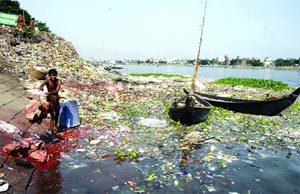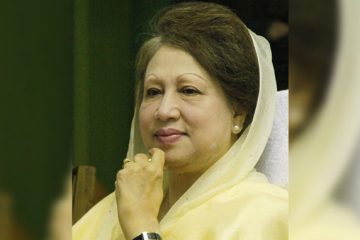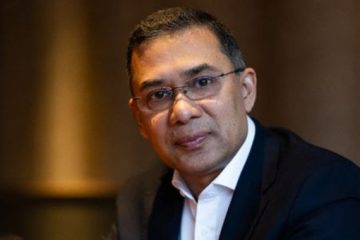 The cleansing drive in the River Buriganga has proved futile as the authorities concerned failed to stop discharge by active polluting sources which are still dumping 25,000 tonnes of untreated wastes and 60,000 cubic metres of toxic chemicals into the river everyday, reports NewAge.
The cleansing drive in the River Buriganga has proved futile as the authorities concerned failed to stop discharge by active polluting sources which are still dumping 25,000 tonnes of untreated wastes and 60,000 cubic metres of toxic chemicals into the river everyday, reports NewAge.
The Bangladesh Inland Water Transport Authority began its much-vaunted Buriganga cleansing operation in January to remove around 300 tonnes of garbage from the riverbed at a cost of Tk 24.9 crore.
Locals and people concerned have said the quality of the Buriganga water had not improved to the extent the authorities expected as the dumping of waste and discharge of industrial effluents were continuing while the first phase of the drive ended in May.
The BIWTA authorities said they would resume the drive in September.
Buriganga cleansing drive project director Rokibul Islam Talukder admitted the fact saying, ‘The drive would not be of much benefit if pollution is not stopped.’
‘We requested the agencies concerned, including Dhaka City Corporation and the Department of Environment repeatedly to take necessary measures to stop discharge of waste and effluent,’ he said.
Rokibul said the BIWTA had also carried out an awareness campaign against dumping of waste into the river. ‘But people still dump waste into the river.’
He, however, insisted that the Buriganga water quality had improved to some extent.
When contacted, DCC chief executive officer Abul Kalam Azad said that the corporation had kept a good number of garbage cans along the river so that locals could use them.
‘What can the DCC do if the people dump garbage into the river instead of using the containers,’ he said.
Save the Environment Movement chairman Abu Naser Khan, who was a member of the task force for Buriganga cleansing drive, said the drive was conducted in a scattered way. ‘You should make a comprehensive and coordinated move for its success.’
The green activist observed that the water quality of Buriganga would not improve until and unless discharge of industrial wastes and chemicals into the river was stopped once and for all.
Due to indiscriminate disposal of industrial effluents, wastewater, sewage, solid waste and toxic chemicals, pollution of Buriganga and other rivers around Dhaka has reached an alarming level that prompted the authorities concerned to go for the cleansing drive.
A report of the Task Force on Sustenance of Navigation and Restoration of Natural Course and Flow of Buriganga River showed that about 60 per cent of pollutants were generated from industries and the remaining 40 per cent from domestic wastewater, municipal sewage as well as solid waste.
As per the report of May 2008, there are more than 3,000 industrial units within the city limits and over 7,000 such installations in the drainage area of the rivers surrounding Dhaka city, including Buriganga.
The most polluting units include tannery, leather, textile, dying, chemicals, pharmaceuticals, metals, cement, pulp and paper boards, food processing, etc. These industries discharge about 60,000 cubic metres of toxic wastes per day mainly from nine industrial clusters – Tongi, Hazaribagh, Tejgaon, Tarabo, Narayanganj, Savar, Gazipur, Dhaka EPZ, and Ghorashal.
The prospect for relocating the tanneries now seem uncertain while the industry and commerce ministries asked the finance ministry to seek extension of time from the High Court for their relocation.




















